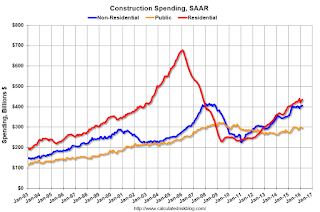by Calculated Risk on 5/02/2016 12:31:00 PM
Monday, May 02, 2016
Construction Spending increased 0.3% in March
Earlier today, the Census Bureau reported that overall construction spending increased 0.3% in March compared to February:
The U.S. Census Bureau of the Department of Commerce announced today that construction spending during March 2016 was estimated at a seasonally adjusted annual rate of $1,137.5 billion, 0.3 percent above the revised February estimate of $1,133.6 billion. The March figure is 8.0 percent above the March 2015 estimate of $1,052.9 billion.Private spending increased and public spending decreased in March:
Spending on private construction was at a seasonally adjusted annual rate of $842.3 billion, 1.1 percent above the revised February estimate of $832.8 billion. ...
In March, the estimated seasonally adjusted annual rate of public construction spending was $295.2 billion, 1.9 percent below the revised February estimate of $300.8 billion.
emphasis added
 Click on graph for larger image.
Click on graph for larger image.This graph shows private residential and nonresidential construction spending, and public spending, since 1993. Note: nominal dollars, not inflation adjusted.
Private residential spending has been increasing, but is 36% below the bubble peak.
Non-residential spending is only 2% below the peak in January 2008 (nominal dollars).
Public construction spending is now 9% below the peak in March 2009.
 The second graph shows the year-over-year change in construction spending.
The second graph shows the year-over-year change in construction spending.On a year-over-year basis, private residential construction spending is up 8%. Non-residential spending is up 9% year-over-year. Public spending is up 7% year-over-year.
Looking forward, all categories of construction spending should increase in 2016. Residential spending is still very low, non-residential is increasing (except oil and gas), and public spending is also increasing after several years of austerity.
This was below the consensus forecast of a 0.5% increase for March, and construction spending for February and January were revised down.


